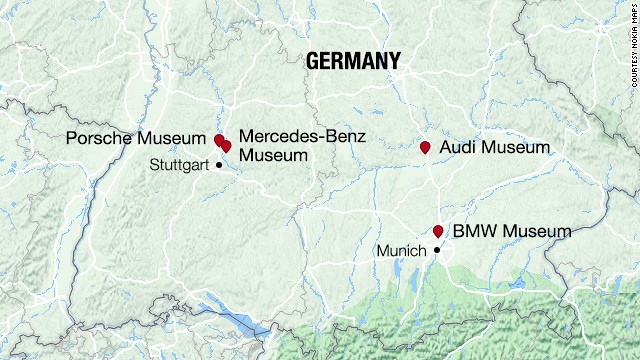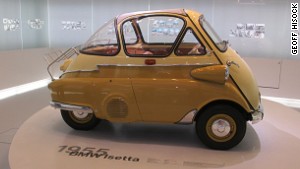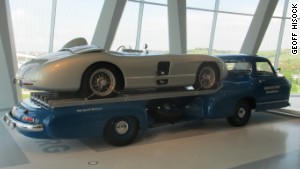Petrolhead paradise: Touring Germany's world-class automotive museumsPetrolhead天堂:房德國的世界級汽車博物館
- Three cities in southern Germany host museums dedicated to the country's leading car brands
- Enthusiasts can tour collections of priceless cars made by BMW, Audis, Mercedes-Benz and Porsche
- The museums can be explored in two days using Munich or Stuttgart as a base
(CNN) -- In the automotive world, good things often come in fours.
Four doors, four-wheel drive and, in one corner of Germany, four of the planet's finest motoring museums.
And you don't even need a car to visit them.
Germany's premium motoring brands can be seen the world over, but only in Bavaria and Baden-Wurttemberg, where their manufacturers -- Audi, BMW, Mercedes-Benz and Porsche -- have established the museums in their honor can their legacy be fully appreciated.
Between them, the collections based in a magic motoring triangle that connects the cities of Stuttgart, Munich and Ingolstadt, are a priceless showcase of automotive history.
The hundreds of cars, trucks and motorbikes on display range from the pioneering creations of Gottlieb Daimler, Carl Benz and August Horch through to the futuristic prewar designs of Ferdinand Porsche and on to the high-tech vehicles of the modern era.
For car enthusiasts -- or simply anyone interested in the technology of modern transport, global brand values and remarkable architecture -- these state-of-the-art museums create a touring "golden triangle" that can be covered in a couple of days using Stuttgart or Munich as a base.
Innovation, engineering excellence, historic achievement and a sense of style are some of the factors that exemplify the vehicles on display.
MORE: Riding shotgun in the Gumball 3000
Ethereal aluminum body
An example is the first exhibit a visitor encounters at the Porsche Museum in Stuttgart: the ethereal aluminum body shape of the 1939 Type 64.
Clearly the forerunner of all Porsches, this tiny streamlined prototype was designed as a long-distance racing coupe by company founder Ferdinand Porsche.
After World War II, it was the first car to carry the family name, ahead of the Porsche 356 No. 1.
Not far from the Type 64 is a car that began Porsche's long association with the Le Mans 24-hour race in France.
In 1951, a 1.1 liter Porsche 356 SL coupe bearing the number 46 competed in the race, winning its class and finishing 20th overall.
Between 1970 and 1987, Porsche was the outright winner 12 times at Le Mans, and added another four wins in the 1990s.
The massive collection at the Mercedes-Benz Museum, also in Stuttgart, includes such historical masterpieces as the Benz Patent-Motorwagen of 1885, the first Daimler motor car of 1892, the supercharged Mercedes-Benz roadsters of the 1920s and 1930s, through to the quirky high-speed transporter built to carry the 300 SLR sports racer to the track.
On one wall of the museum stands the 1939 six-wheeled T80 world record car, originally fitted with a 44-liter V12 engine that was designed to reach a speed of 600 kilometers per hour (372 mph).
Plans for a record attempt were undone by the advent of World War II; the car was mothballed and its engine removed.
Mercedes' racing heritage is prominent, culminating in a spectacular lineup of its Silver Arrow grand prix and sports racing cars.
Outside the museum, a bronze statue depicts five-time world champion F1 driver Juan Manuel Fangio standing next to his 1954 W196 grand prix racer.
Audi, created by engineer August Horch in 1910, consolidated its brand in 1932 when it joined with Wanderer and DKW to form Auto Union under the "four rings" emblem.
MORE: Ferrari designers create super-luxurious train
Flowing silver masterpiece
Examples of all these marques can be found at the Audi Museum, along with Audi's Le Mans-winning sports racers, the Quattro rally championship cars and the "baby Thunderbird" Auto Union 1000 SP.
One highlight of the Audi display is a flowing silver masterpiece known as the 1937 Auto Union V16 Type C Streamliner racing car.
The car on show is a modern recreation of the Streamliner that German driver Bernd Rosemeyer took to a speed of more than 400 kmh on the Frankfurt-Darmstadt autobahn in October 1937, the first time the mark was reached on a normal road.
Rosemeyer was killed in 1938 during a similar speed attempt on the same road.
In Munich, most people arrive by subway to BMW Welt, which is a showroom and delivery center for its contemporary BMW, Mini and Rolls-Royce brands.
A pedestrian bridge links this with the silver bowl-shaped BMW Museum across the road.

The museum pays homage to the company's aero engine origins and to its F1 racing endeavors with Brabham, Williams and Sauber, but primarily features a superb range of prewar and postwar BMW saloons, roadsters and coupes, along with its current crop of high-technology vehicles such as the i8 concept car.
Highlights include a roadster and coupe versions of the classic 1939 328 model, while curiosities such as the 1955 Isetta bubble car enliven the display.
Between them, the four museums can easily soak up four days of visitor time, particularly if the factory tours are included.
Either Stuttgart or Munich makes a great base.
They are two of Germany's most liveable and appealing cities -- easy on the eye, great transportation systems and not too expensive.
The business-style hotel chain Motel One, for example, offers rooms close to the main stations for €60 to €80 ($80-$107) outside peak season.
If time permits, Germany's other great auto museum, Volkswagen's sprawling Autostadt, lies 600 kilometers north of Munich in the city of Wolfsburg, about an hour by train west of Berlin.
Munich to Berlin takes about six hours by car or train.
Getting there
InterCity Express (ICE) train services link Munich and Stuttgart in a little over two hours, while Ingolstadt is 40 minutes by train from Munich. For those with a more detailed interest, it's possible to arrange factory production tours at all four sites.
Porsche Museum
Open 9 a.m.-6 p.m., Tuesday to Sunday. Closed Monday. Admission €8 adult and €4 child/concession. Factory tour is free (reservation required). Email: factorytours@porsche.de
By train: From Stuttgart main station, take the S-Bahn S6 line towards Weil der Stadt/Leonberg; get off at Neuwirtshaus/Porscheplatz station. The museum is next to the station.
Porsche Museum, Porscheplatz 1, Stuttgart-Zuffenhausen
Mercedes-Benz Museum
Open 9 a.m.-6 p.m., Tuesday to Sunday. Closed Monday. Admission €8 and €4. Factory tour is €4 (reservation recommended). Email: dialog@daimler.com
By train: From Stuttgart main station, take the S-Bahn S1 line towards Kirchheim (Teck); get off at Neckarpark (Mercedes-Benz) and follow signs to museum.
Mercedes-Benz Museum, Mercedesstrasse 100, Stuttgart
BMW Museum
Open 10 a.m.-6 p.m., Tuesday to Sunday. Closed Monday. Admission €9 and €6. The adjacent BMW Welt (new car display area, restaurant, shop) is free and open daily from 7:30 a.m. to midnight. Factory tour is €8 (reservation required). Email: infowelt@bmw-welt.com
By train: From Munich main station, take the S-Bahn to Marienplatz, change to U3 (subway) toward Olympia-Einkaufszentrum; get off at Olympiazentrum. BMW Welt is next to the subway station; the museum is linked to BMW Welt by an overhead walkway.
BMW Museum, Am Olympiapark 2, Munich
Audi Museum
Open 9 a.m.-6 p.m., daily.
By train: From Munich main station, take ICE train to Ingolstadt Hbf (40 minutes), then bus No. 11 or taxi to Audi Forum. Admission €4 and €2. Factory tour Monday-Friday 11:30 a.m. (booking required), €7 and €3.50. Email: welcome@audi.de
Audi Museum, part of Audi Forum, Ettinger Strasse, Ingolstadt
Petrolhead天堂:房德國的世界級汽車博物館
由傑夫希斯科克,為CNN
2014年7月24日 - 更新0710 GMT(1510 HKT)
被稱為“傳奇跑車”的328是20世紀30年代提出的幾個版本的寶馬。 這種模式是在顯示在寶馬世界慕尼黑。 被稱為“傳奇跑車”的328是20世紀30年代提出的幾個版本的寶馬。這種模式是在顯示在寶馬世界慕尼黑。
隱藏字幕
德國的駕駛聖地
<<
<
1 2 3 4 5 6 7 8 9 10
>
>>
故事突出
三個城市在德國南部主機博物館致力於全國領先的汽車品牌
愛好者可以參觀的是寶馬,奧迪,奔馳和保時捷做出無價的汽車收藏品
博物館可以使用慕尼黑或斯圖加特為基地兩天內探索
(CNN) -在汽車的世界裡,好東西常常是在四肢。
四門,四輪驅動,在一個角落裡德國的四星球上最好的駕駛博物館。
而你甚至都不需要一輛車去拜訪他們。
德國的高檔汽車的品牌可以看出,在世界各地,但只在巴伐利亞州和巴登 - 符騰堡州,在那裡他們的製造商 - 奧迪,寶馬,奔馳和保時捷 - 已經建立了自己的榮譽博物館可以在他們的遺產得到充分的讚賞。
在他們之間,總部設在一個神奇的駕駛三角形連接的斯圖加特,慕尼黑和英戈爾斯塔特的城市的集合,是汽車歷史上的一個無價的展示。
數以百計的汽車,卡車和顯示範圍從戈特利布·戴姆勒,卡爾·本茨和八月霍希通過開拓創作費迪南德保時捷的未來戰前設計和現代時代的高科技汽車摩托車。
對於汽車愛好者 - 或者只是有興趣在現代運輸技術,全球品牌價值和卓越的建築 - 國家的最先進的這些博物館創造一個旅遊“金三角”,可以使用覆蓋在一兩天斯圖加特和慕尼黑的魅力。
創新,卓越工程,歷史性的成就和造型感是一些體現車輛上顯示的因素。
更多:在口香糖3000騎獵槍
空靈的鋁製車身
一個例子是第一個展覽訪客遇到的保時捷博物館在斯圖加特:1939年64型空靈鋁製車身形狀。
很明顯,所有保時捷的先驅,這個微小的簡化原型被設計成一個長距離賽車跑車由公司創始人費迪南德·保時捷。
第二次世界大戰後,這是第一輛攜帶姓,前面的保時捷356號1。
不遠處的64型是一輛汽車,開始了保時捷與勒芒24小時耐力賽在法國長期合作關係。
1951年,一個1.1升保時捷356 SL跑車軸承數46在比賽中競爭,贏得了階級和整理第20順位。
1970年至1987年,保時捷是無可爭議的勝出12次在勒芒,並且增加了另外四勝在上世紀90年代。
在大量收集在梅賽德斯 - 奔馳博物館,也是在斯圖加特,包括諸如歷史的傳世之作的奔馳專利 - Motorwagen 1885年,第一戴姆勒電動車1892年,20世紀20年代和30年代的機械增壓的奔馳跑車,通過對古怪的高速轉運內置攜帶300 SLR賽車運動的軌跡。
在一個牆的博物館矗立著1939年六輪T80世界紀錄的車,原本配備的目的是要達到每小時600公里(372英里每小時)的速度一個44升的V12發動機。
1955年寶馬ISETTA泡沫車,寶馬博物館,德國。
1955年寶馬ISETTA泡沫車,寶馬博物館,德國。
計劃為創紀錄的嘗試是由第二次世界大戰的到來撤消; 車被封存和它的引擎刪除。
梅賽德斯的賽車傳統是突出,最終在其銀箭大獎賽和體育賽車的壯觀陣容。
館外,銅像描繪了5次世界冠軍的F1車手胡安 - 曼紐爾 - 方吉奧站在旁邊的他1954年W196大獎賽的賽車手。
奧迪,由工程師八月霍希於1910年創建,鞏固其品牌在1932年,當它與流浪者和DKW加入,形成汽車聯盟下的“四環”標誌。
更多:法拉利設計師打造超豪華列車
流銀的傑作
所有這些私人物品的例子可以在奧迪博物館被發現,隨著奧迪的勒芒殊榮的體育選手,Quattro的汽車拉力錦標賽賽車和“嬰兒雷鳥”汽車聯盟1000 SP。
奧迪展示的一個亮點是一個流動的銀傑作被稱為1937年汽車聯盟的V16 C型的Streamliner賽車。
汽車上秀是的Streamliner的現代休閒的德國車手貝恩德Rosemeyer走上超過400公里每小時的速度在法蘭克福,達姆施塔特高速公路在1937年10月,在第一時間標記達成了一個正常的道路。
Rosemeyer是在同一條道路上類似的速度企圖殺害於1938年。
在慕尼黑,大多數人到達地鐵到寶馬世界,這是一個陳列室和交付中心,為當代BMW,MINI和勞斯萊斯品牌。
行人橋這個鏈接與銀色碗狀的寶馬博物館隔路相望。
駕駛博物館地圖駕駛博物館地圖
該博物館致敬的公司的航空發動機的起源,以及其F1賽車的努力與布拉漢姆,威廉姆斯和索伯,但主要是提供一個一流的一系列戰前和戰後的寶馬轎車,跑車和雙門轎跑車,以及其目前的高科技汽車作物如i8的概念車。
亮點包括1939年的經典機型328的敞篷跑車和轎跑車版本,而珍品,如1955年ISETTA泡沫車搞活顯示。
在他們之間,四個博物館可以輕鬆享受四天遊客時間,特別是如果工廠參觀也包括在內。
無論是斯圖加特和慕尼黑的理想基地。
他們是兩個德國最適宜居住和吸引力的城市 - 容易對眼睛,大運輸系統,而不是太昂貴了。
商務風格的酒店連鎖Motel One酒店,例如,提供靠近為€60到€80(美元80 - 107)主站旺季之外。
如果時間允許,德國的其他偉大的汽車博物館,大眾汽車的龐大的Autostadt,位於慕尼黑以北600公里在城市沃爾夫斯堡,大約一個小時的火車西柏林。
慕尼黑到柏林約需六小時的汽車或火車。
交通指南
城際特快(ICE)的列車服務在一個小鏈接慕尼黑和斯圖加特兩個多小時,而英戈爾斯塔特40分鐘即可抵達慕尼黑的火車。對於那些更詳細的利益,有可能安排工廠生產旅行團在所有四個地點。
保時捷博物館
打開至週日上午9點至下午6點,週二。週一閉館。門票€8成人級和€4個子/讓步。工廠參觀是免費的(需預約)。電子郵件:factorytours@porsche.de
乘火車:從斯圖加特主火車站,乘坐朝威爾河畔城市州/萊昂貝格的S-Bahn輕軌S6線; 下車Neuwirtshaus旅遊/保時捷站。該博物館是車站旁。
1955年梅賽德斯 - 奔馳的高速轉運。
1955年梅賽德斯 - 奔馳的高速轉運。
保時捷博物館,保時捷1,斯圖加特-祖文豪森
梅賽德斯 - 奔馳博物館
打開至週日上午9點至下午6點,週二。週一閉館。入學€8和€4 參觀工廠是€4(建議預約)。電子郵件:dialog@daimler.com
乘火車:從斯圖加特主火車站,乘坐朝基希海姆(德)的S-Bahn輕軌S1線; 下車內卡(梅賽德斯 - 奔馳),並按照標誌的博物館。
梅賽德斯-奔馳博物館,Mercedesstrasse 100,斯圖加特
寶馬博物館
打開至週日上午10點至下午6點,週二。週一閉館。入學€9€6 相鄰的寶馬世界(新車展示區,餐廳,商店)是免費的,每天從上午7:30開放至午夜。參觀工廠是€8(需預約)。電子郵件:infowelt@bmw-welt.com
火車:從慕尼黑中央火車站出發,乘坐輕軌到瑪利亞廣場,變更為U3(地鐵)對奧林匹亞Einkaufszentrum; 下車Olympiazentrum。寶馬世界是旁邊的地鐵站; 該博物館是由一個天橋連接到寶馬世界。
寶馬博物館,奧林匹亞2,慕尼黑
奧迪博物館
打開上午9時至下午6時,每天。
火車:從慕尼黑中央火車站,乘坐ICE火車到英戈爾斯塔特HBF(40分鐘),然後巴士11號或的士到奧迪論壇。入學€4和€2 工廠參觀週一至週五上午11:30(需預約),€7€3,50。電子郵件:welcome@audi.de
奧迪博物館,奧迪論壇,艾丁格大街,英戈爾斯塔特的一部分
 Known as the "Legendary Roadster," the 328 was made in several versions by BMW during the 1930s. This model is on display at BMW World in Munich.
Known as the "Legendary Roadster," the 328 was made in several versions by BMW during the 1930s. This model is on display at BMW World in Munich.




 留言列表
留言列表
 {{ article.title }}
{{ article.title }}

